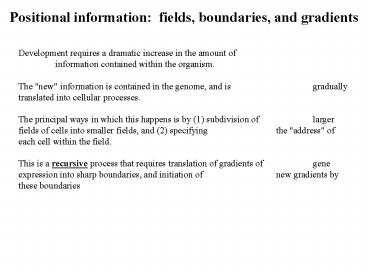Positional information: fields, boundaries, and gradients - PowerPoint PPT Presentation
Title:
Positional information: fields, boundaries, and gradients
Description:
Positional cues (Pattern formation) ... genes and axial patterning. Combinatorial specification of ... Axial patterning by overlapping regional determinants ... – PowerPoint PPT presentation
Number of Views:79
Avg rating:3.0/5.0
Title: Positional information: fields, boundaries, and gradients
1
Positional information fields, boundaries, and
gradients
Development requires a dramatic increase in the
amount of information contained within the
organism. The "new" information is contained
in the genome, and is gradually translated
into cellular processes. The principal ways in
which this happens is by (1) subdivision of
larger fields of cells into smaller fields, and
(2) specifying the "address" of each cell
within the field. This is a recursive process
that requires translation of gradients of gene
expression into sharp boundaries, and initiation
of new gradients by these boundaries
2
Specification of cell fates
Positional cues (Pattern formation) Cell fate
is determined by its spatial position within a
morphogenetic field during a critical time
period Historical cues (Cell lineage) Cell
fate is determined by inherited molecules or gene
expression states Both mechanisms are required
for cell specification, and often act
simultaneously.
3
Pattern formation
Y
Cell fate
Cue 2
Cue 1
X
Morphogenetic (progenitor) field is a region or a
group of cells that show no overt
differentiation, but that is destined to give
rise to a particular organ or structure.
Morphogenetic fields are to some extent
autonomous and integrated.
4
Primary and secondary fields
Y
etc.
X
5
Morphogen gradients
A morphogen is a (usually) secreted molecule that
induces cell fate decisions in recipient cells in
a concentration-dependent manner Requires Spati
ally restricted production Long-range
distribution (passive or active) Reception and
interpretation Interpretation is
context-dependent Most animal morphogens belong
to a small number of well-conserved and widely
distributed families
6
Morphogen gradient
Source
Concentration
Positional information
Position
Positional information may include both scalar
and vector components (distance and direction)
7
Gradients and cell polarity
8
Wolpert's "French flag" model
Single gradient
9
Wolpert's "French flag" model
Double gradient
10
Signal transduction
11
Positional information is translated into the
activation and repression of target genes
Responses to morphogen gradients activation /
repression of target genes cell proliferation
and growth morphogenetic movements Responses
are context-specific
12
Translating boundary into gradient
dpp
Boundary of Engrailed expression serves as the
source of Hedgehog gradient Hedgehog activates
expression of a second morphogen, Dpp, which
establishes a bidirectional gradient
ci
en
ci
ptc
smo
ci
hh
Hh
13
Translating gradient into boundary
14
Threshold responses to the Dorsal morphogen
gradient
sna
sog
zen
15
Threshold responses to the Dpp morphogen gradient
16
Threshold responses to the Dpp morphogen gradient
hnt
ush
(Lost in dpp / - )
17
After the gradient Refining position-specific
cell fates
msh
ind
vnd
18
After the gradient Refining position-specific
cell fates
Cowden and Levine 2003
19
Short-range (contact-mediated) signaling
Notch signaling
20
Sensory organ precursor lineage in Drosophila
21
Interplay of position and lineage
22
Context-dependent action of morphogen gradients
Dorso-ventral
Anterior-posterior
sna
sog
zen
Same morphogen, different targets, different
responses
23
"Selector genes" provide the context in which
positional information is interpreted
Act as digital switches that toggle between
distinct fates Can be induced by morphogens or
other selector genes Form multi-layer hierarchies
24
Signaling pathways activate selector genes and
vice versa
Dpp
Wg
Distal-less
EGFR
Target genes, including other selectors and
signals
25
Types of selector genes
Spatial region
Organ
Cell / tissue type
26
HOX genes and axial patterning
27
Combinatorial specification of cell fates
28
Combinatorial control of cell fates
Signal 1
Signal 2
Selector A
Selector B
Target Gene Z
Target Gene X
Target Gene Y
Cell fate l
Cell fate y
Cell fate z
A relatively small toolkit of signals and
selector genes can specify a wide range of cell
fates by a combinatorial mechanism
29
Control of gene expression by selector genes and
signaling pathways
Different signal/selector combinations define
different cell fates and gene expression domains
30
Precise spatial control of cell fates
Culi and Modolell 1998
31
Precise spatial control of cell fates
Garcia-Garcia et al 1999
32
Precise spatial control of cell fates
Renaud and Simpson 2002
33
Combinatorial control by overlapping selectors
Selector A
Selector C
Selector B
Cell fate 1
Cell fate 5
Cell fate 2
Cell fate 4
Cell fate 3
34
Axial patterning by overlapping regional
determinants
Multiple positions along the Proximo-Distal axis
are defined by selector genes expressed in
overlapping concentric domains
35
Axial patterning by overlapping regional
determinants
Kojima 2004
36
Progressive regionalization of morphogenetic
fields
37
Combinations of regional identities establish new
regional identities
38
Regulatory hierarchies in development
39
Genes and molecules that control animal
development are widely conserved
Signaling pathways
Hedgehog Notch Dpp/ TGFb Ras/ raf Wingless/
Wnt Jak/ Stat
Selector genes
HOX genes eyeless/ Pax6 (eye
development) Distal-less (appendages) tinman
(heart)































